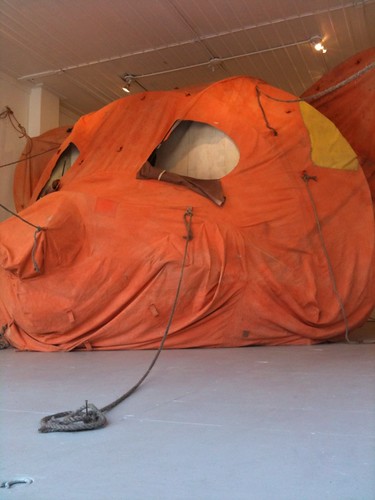 Lesley Williamson is a guest blogger. While completing a Master of Arts Management degree at Carnegie Mellon University, she is interning in the Mattress Factory's marketing department and will be posting here regularly through May. Lesley and her husband David Coester, a classical guitarist, make their home in Dunkirk, NY where they occasionally share custody of two small brown geriatric border terrier dogs. (It's a long story.)
Lesley Williamson is a guest blogger. While completing a Master of Arts Management degree at Carnegie Mellon University, she is interning in the Mattress Factory's marketing department and will be posting here regularly through May. Lesley and her husband David Coester, a classical guitarist, make their home in Dunkirk, NY where they occasionally share custody of two small brown geriatric border terrier dogs. (It's a long story.)Most people don’t normally look forward to staff meetings. But I have secretly enjoyed them at the Mattress Factory. You can learn a lot about an organization’s culture while sitting around the boardroom table.
There are two main reasons why I like these meetings. First, we’re always well fed. (Very important!) Pastries and fruit and frequent birthday cakes come spilling out of the galley kitchen around the corner. Mimosas made an appearance a while back. I can’t remember the occasion. I’m sure there was one.
Second, and not surprisingly, Mattress Factory staff meetings reflect the habit of creativity and collaboration that defines the museum. Of course there are the perfunctory updates on installations, future exhibitions, and numbers of tours and workshops offered.
But it’s also apparent that everyone is thinking about art all the time. A few weeks ago Lindsay presented a bold, brilliant marketing idea concerning a future installation that would involve painting the entire roof. (Everyone volunteered.) This morning Nathan announced that his original orchestral composition was having its premiere in Oakland later in the week. He had tickets for sale.
 This morning's meeting also included a lively discussion about Brian Griffiths’ The Body and Ground (or Your Lovely Smile), a giant, orange, tent-like tethered bear head that fills the entire first room of the gallery at 1414 Monterey Street where Nothing is impossible opened last Friday. There have already been tours in the gallery, and there seemed to be a lack of clarity about how the piece should be interpreted by the guide.
This morning's meeting also included a lively discussion about Brian Griffiths’ The Body and Ground (or Your Lovely Smile), a giant, orange, tent-like tethered bear head that fills the entire first room of the gallery at 1414 Monterey Street where Nothing is impossible opened last Friday. There have already been tours in the gallery, and there seemed to be a lack of clarity about how the piece should be interpreted by the guide.Under-caffeinated, Liz, Education Programs Coordinator, said that she struggled to get a straight answer out of Brian before the end of his two-month residency. He said one thing. The curator Georgina Jackson said something else. The tour guide seemed suspicious and wasn’t warming up to the piece.
Comments and questions came rapid-fire. “I heard someone at the opening say it looked like a giant gas mask.” “Did Brian explain why the bear was tethered?” “My three year-old is convinced it’s a mouse.” “Why a bear and not some other animal?” “Is that really tent material?” “I thought there was something subterranean about it, with that decapitated head above ground.”
What I most loved about this conversation was how candid and honest it was. There was an implicit understanding that it was perfectly ok to have questions. That it was ok not to “get it.” Cross another silly stereotype off my list: people who work at art museums don’t always understand the art. Fancy that! It’s perfectly alright to be confused. I’m sure you can relate.
But Anna, Director of Education, raised a great question: whose explanation of the piece does the museum use – the artist’s or the curator’s? Sharing and interpreting works of art is one of the fundamental missions of any art museum. If there is no clarity around this point, the museum risks misrepresenting the work and misinforming the public. In the end, the answer was “both”.
Did you come to the opening? What do you think about The Body and Ground (or Your Lovely Smile)? Let us know your thoughts in the comment box below.

1 comment:
I attended the opening, and I, too, thought it was a mouse. But there was something about the piece that I really loved. To me it spoke of Saturday-morning cartoons and the potential for the ridiculous and surreal to become tangible, and even, possibly, to take flight. All Macy's Parade floats and hot-air-balloon tales.
I also love that everyone is having a different reaction. Among the people I attended the opening with there were very different reactions to the piece. We're all arts students, and I actually really appreciated that we could just say, "I like it," or "I don't like it," and didn't *need* to analyze.
It is refreshing to hear that even the artist was unable or unwilling to attribute a complicated explanation to the piece....sometimes I think we need a break from "why" and just allow ourselves to react.
Post a Comment